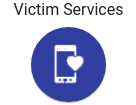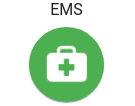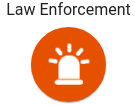The Vicarious Trauma—Organizational Readiness Guide (VT–ORG) was created specifically for the Vicarious Trauma Toolkit (VTT) to help organizations assess their capacity to address employees' work-related exposure to trauma and prioritize organizational needs, and to assist in navigating the VTT and the Compendium of Resources.
Framework for the VT–ORG
The VT–ORG's evidence-informed framework relies on practice wisdom and research literature from the fields of public health, medicine, psychiatry, law, social work, criminal justice, clinical and organizational psychology, and other social sciences, among others. It is organized around organizational strategies that reduce, or have the potential to reduce, the impact of vicarious trauma. In addition to an extensive review of the research literature, the VTT Project Team conducted a national survey and pilot study that revealed that many organizations knew the importance of addressing vicarious trauma, but simply did not know where to start, what goals to set, or how to determine if they had reached their goals. Consultants knowledgeable in organizational psychology and relational coordination theories lent their expertise to ensure that the VT–ORG aligned with sound organizational practices and research evidence.
The VTT pilot sites helped to further refine the VT–ORG by providing insightful recommendations about its usefulness for their settings. All of the steps taken by the VTT Project Team helped gather beneficial resources currently being used in the field and ensure that the VT–ORG is practice-focused and relevant to each of the victim service and first responder disciplines.
The Five Organizational Strategies
The VTT Project Team evolved the concept of a vicarious trauma-informed organization as one that proactively assumes the responsibility to recognize and address the needs of staff in these five evidence-informed areas of organizational health:
- Leadership and Mission
- Management and Supervision
- Employee Empowerment and Work Environment
- Training and Professional Development
- Staff Health and Wellness
Leadership and Mission
To address the impact of vicarious trauma, leaders in vicarious trauma-informed organizations proactively integrate strategies into workplace values, operations, and practices; maintain a clear vision that supports and articulates the agency's mission; and regularly model and promote open and respectful communication.
What the research literature tells us:
- Leadership can sustain staff by anticipating and responding to staff needs, showing appreciation, and creating safe forums for communication (McFarlane and Bryant 2007; Howlett and Collins 2014).
- Advocates who received more support from supervisors, coworkers, and work teams experienced lower levels of secondary traumatic stress (Slattery and Goodman 2009).
- Open and transparent communication regarding organizational mission, strategy, resources, and implementation of policies and procedures provides a strong foundation within the agency (Brondolo et al. 2008).
- Greater access to the organization's strategic information lowers levels of vicarious trauma (Choi 2011).
Management and Supervision
To fulfill their obligation to lessen the impact of vicarious trauma, managers and supervisors in vicarious trauma-informed organizations foster supportive relationships based on inclusivity, mutual respect, and trust; promote policies and practices that lessen the negative impact of the work; seek out and support staff following critical or acute incidents; and conduct performance evaluations that include discussions of vicarious trauma.
What the research literature tells us:
- Quality supervision—when staff feel safe and respected—enables staff to overcome high workloads and stay on the job (Slattery and Goodman 2009; Bednar 2003).
- Having a structured protocol in place for case review, along with collegial team reflection and support, helps counter the impact of vicarious trauma and secondary traumatic stress (Howlett and Collins 2014; Geller, Madsen, and Ohrenstein 2004).
Employee Empowerment and Work Environment
To promote and maintain a healthy work environment, vicarious trauma-informed organizations foster teamwork; encourage collaboration both within and outside the organization; create formal and informal opportunities for staff to connect with one another; and offer opportunities to diversify job tasks.
What the research literature tells us:
- Positive work environments provide quality service outcomes and decrease staff turnover (Glisson and Green 2006; Shim 2010; Strolin-Goltzman 2009).
- Supportive work environments reduce the negative impact of vicarious trauma (Bell, Kulkarni, and Dalton 2003; Slattery and Goodman 2009).
Training and Professional Development
To strive for professional competency, capacity, and staff retention, vicarious trauma-informed organizations promote continuing education, professional development, and networking opportunities; provide thorough orientation and ongoing training; enable access to resources; and support staff participation in on- and offsite learning opportunities.
What the research literature tells us:
- Being trained in vicarious traumatization benefits both participants and the populations they serve (Gentry, Baggerly, and Baranowsky 2003).
- Job-specific training strengthens confidence and competence in performance and builds networks (Saakvitne and Pearlman 1996; Bell, Kulkarni, and Dalton 2003; Howlett and Collins 2014).
Staff Health and Wellness
To maintain the health and wellness of their staff, vicarious trauma-informed organizations recognize links between health/wellness and staff satisfaction and productivity; devote time and resources to promoting staff well-being; encourage and provide health and wellness activities; and incorporate wellness into policies and practices.
What the research literature tells us:
- Mindfulness programs increase compassion satisfaction and decrease compassion fatigue (Thieleman and Cacciatore 2014).
How To Use the VT–ORG
Do It Yourself - For a step-by step guide to using the VT–ORG to assess your organization’s current capacity in the five evidence-informed areas of organizational health, identify priority needs and next steps, and locate relevant resources and tools in the toolkit that address those needs, see the Blueprint for a Vicarious Trauma-Informed Organization.
Let Us Help - The OVC Training and Technical Assistance Center (OVC TTAC) offers training and technical assistance on the toolkit at no cost through a range of formats. If you’re interested in bringing the Vicarious Trauma Toolkit to your organization or community, contact OVC TTAC to hear about TTA options that include conference workshops, customized training, and virtual technical assistance to assess where your organization or community is now and to create an action plan. Visit www.ovcttac.gov to find out how to apply or call 1–866–682–8822 for more information.
Access Your VT–ORG
Choose one of the disciplines below to access the most appropriate VT–ORG for your agency.





